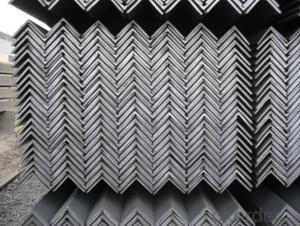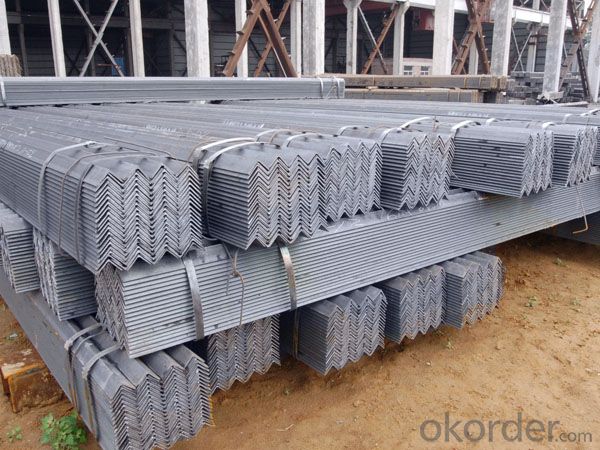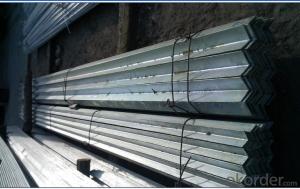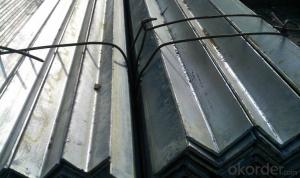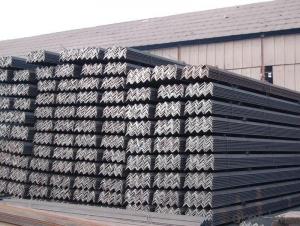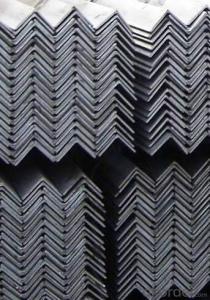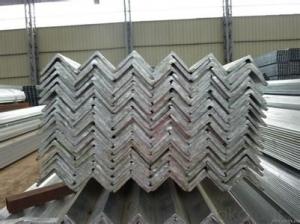ANGLE STEEL HIGH QUALITY HOT ROLLED 20-250MM GB Standard
- Loading Port:
- Tianjin
- Payment Terms:
- TT OR LC
- Min Order Qty:
- 25 m.t.
- Supply Capability:
- 20000000 m.t./month
OKorder Service Pledge
OKorder Financial Service
You Might Also Like
Specification
Product Description:
OKorder is offering ANGLE STEEL HIGH QUALITY HOT ROLLED 20-250MM GB Standard at great prices with worldwide shipping. Our supplier is a world-class manufacturer of steel, with our products utilized the world over. OKorder annually supplies products to European, North American and Asian markets. We provide quotations within 24 hours of receiving an inquiry and guarantee competitive prices.
Product Applications:
According to the needs of different structures, Angle can compose to different force support component, and also can be the connections between components. It is widely used in various building structures and engineering structures such as roof beams, bridges, transmission towers, hoisting machinery and transport machinery, ships, industrial furnaces, reaction tower, container frame and warehouse etc
Product Advantages:
OKorder's ANGLE STEEL HIGH QUALITY HOT ROLLED 20-250MM GB Standard are durable, strong, and resist corrosion.
Main Product Features:
· Premium quality
· Prompt delivery & seaworthy packing (30 days after receiving deposit)
· Corrosion resistance
· Can be recycled and reused
· Mill test certification
· Professional Service
· Competitive pricing
Product Specifications:
Manufacture: Hot rolled
Grade: Q195 – 235
Certificates: ISO, SGS, BV, CIQ
Length: 6m – 12m, as per customer request
Packaging: Export packing, nude packing, bundled
Sizes: 25mm-250mm | ||||||||||||
a*t | ||||||||||||
25*2.5-4.0 | 70*6.0-9.0 | 130*9.0-15 | ||||||||||
30*2.5-6.6 | 75*6.0-9.0 | 140*10-14 | ||||||||||
36*3.0-5.0 | 80*5.0-10 | 150*10-20 | ||||||||||
38*2.3-6.0 | 90*7.0-10 | 160*10-16 | ||||||||||
40*3.0-5.0 | 100*6.0-12 | 175*12-15 | ||||||||||
45*4.0-6.0 | 110*8.0-10 | 180*12-18 | ||||||||||
50*4.0-6.0 | 120*6.0-15 | 200*14-25 | ||||||||||
60*4.0-8.0 | 125*8.0-14 | 250*25 | ||||||||||
FAQ:
Q1: Why buy Materials & Equipment from OKorder.com?
A1: All products offered byOKorder.com are carefully selected from China's most reliable manufacturing enterprises. Through its ISO certifications, OKorder.com adheres to the highest standards and a commitment to supply chain safety and customer satisfaction.
Q2: How do we guarantee the quality of our products?
A2: We have established an advanced quality management system which conducts strict quality tests at every step, from raw materials to the final product. At the same time, we provide extensive follow-up service assurances as required.
Q3: How soon can we receive the product after purchase?
A3: Within three days of placing an order, we will begin production. The specific shipping date is dependent upon international and government factors, but is typically 7 to 10 workdays.
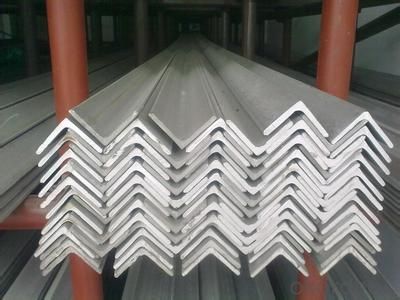
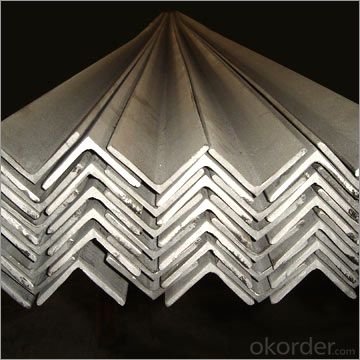
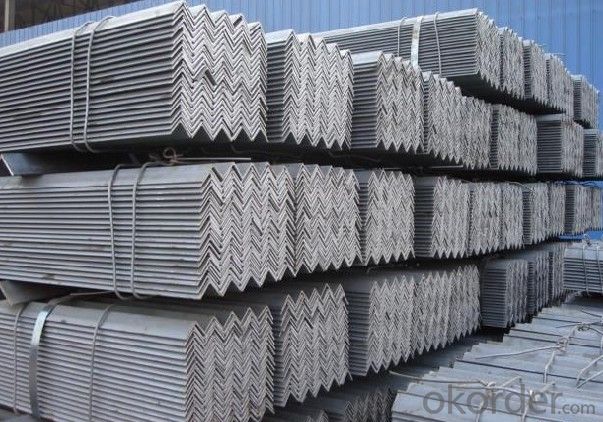
- Q: What are the typical lengths of steel angles available in the market?
- The market offers a range of steel angle lengths to meet specific project needs and requirements. While there are standard lengths readily available, ranging from 20 to 40 feet, such as 20, 25, 30, 35, and 40 feet, customization is also possible through special orders or fabrication. This flexibility allows for meeting precise project requirements in construction and industrial applications, where steel angles are used for structural support, framing, and bracing.
- Q: What are the different methods of cutting steel angles?
- There are various techniques employed for cutting steel angles, depending on the specific needs and resources at hand. Some commonly utilized methods are as follows: 1. Circular or bandsaw cutting: This approach entails using a circular saw or bandsaw equipped with a metal cutting blade. It ensures a clean and precise cut, particularly for smaller angles. 2. Laser cutting: For intricate designs and complex shapes, laser cutting proves highly accurate and efficient. It employs a concentrated laser beam to melt or vaporize the steel angle. 3. Plasma cutting: When dealing with thicker steel angles, plasma cutting is a versatile method that employs a high-temperature plasma arc to melt the metal and eliminate the molten material. 4. Waterjet cutting: This technique involves employing a high-pressure water jet mixed with abrasive particles to erode the steel angle. It is excellent for cutting thick angles and creating intricate patterns. 5. Shearing: For straight cuts, shearing involves using a machine fitted with a sharp blade to slice through the steel angle. It is suitable for thinner angles. 6. Abrasive cutting: By employing a rotary wheel embedded with abrasive particles, abrasive cutting can cut through the steel angle relatively quickly and cost-effectively. However, it may result in a rougher surface. 7. Flame cutting: Flame cutting, also known as oxy-fuel cutting, employs a mixture of fuel gas and oxygen to create a high-temperature flame that melts the steel angle. It is suitable for cutting thicker angles but may result in a heat-affected zone. Each cutting method possesses its own advantages and limitations. The choice of method depends on factors such as the angle's thickness, complexity of the cut, desired precision, and available equipment. Safety precautions must be considered, and the most appropriate method should be selected to ensure a successful and efficient steel angle cutting process.
- Q: How are steel angles installed or fixed in place?
- Steel angles are widely utilized in construction to supply structural support and reinforcement, with their installation or fixation employing various techniques based on the particular application and project requirements. One prevalent approach to installing steel angles is through welding, whereby the angles are permanently fused to the desired location using a welding machine. This method guarantees a robust and long-lasting connection that keeps the angles securely in place, even when subjected to substantial loads or vibrations. However, welding necessitates skilled labor and specialized equipment. Another technique involves bolting, whereby steel angles are affixed to the supporting structure using bolts or screws. This method allows for effortless installation and removal, making it suitable for situations requiring adjustments or modifications. Bolting also offers flexibility in terms of repositioning or replacing the angles if necessary. In certain instances, steel angles are attached to the structure using adhesive bonding, which entails applying a sturdy adhesive material between the angle and the supporting surface. Adhesive bonding proves particularly advantageous when welding or bolting is impractical or undesired. However, it is crucial to ensure that the adhesive employed is suitable for the specific application and capable of withstanding the loads and environmental conditions. Furthermore, a combination of methods can be employed to install steel angles. For instance, welding can serve as the primary attachment, while bolts or adhesive bonding can be employed as secondary supports or reinforcements. Consulting structural engineers or professionals is essential in determining the most appropriate method for installing steel angles, taking into account the project's unique requirements, load conditions, and local building codes. Proper installation guarantees that the angles are securely fixed in place, delivering the necessary strength and stability to the structure.
- Q: Are steel angles suitable for historical restoration projects?
- Yes, steel angles can be suitable for historical restoration projects. They offer excellent strength and durability, which is useful for structural support and reinforcement. Additionally, steel angles can be easily fabricated to match the original design and can be finished to closely resemble the aesthetic of historical materials. However, careful consideration should be given to the specific project requirements and the preservation of historical integrity.
- Q: Are steel angles suitable for vehicle ramps?
- Yes, steel angles are suitable for vehicle ramps. Steel angles provide strength and stability, making them an ideal choice for supporting the weight of vehicles and ensuring safe and durable ramps.
- Q: What is the maximum allowable bearing stress for a steel angle?
- The maximum bearing stress that a steel angle can withstand depends on several factors, including the type of steel, angle thickness and size, and specific application or design requirements. Generally, the maximum bearing stress is determined by assessing the angle's structural strength and stability under expected load conditions. To ascertain the maximum bearing stress for a steel angle, it is vital to refer to relevant industry standards, such as the specifications provided by the American Institute of Steel Construction (AISC) or the Eurocode design standards. These standards offer guidelines and formulas to calculate the maximum bearing stress based on the angle's properties and load factors. Moreover, factors like the presence of additional reinforcements, corrosion or surface imperfections, and the method of connection or support can also impact the maximum bearing stress. Hence, it is crucial to consult the appropriate design codes and seek advice from a structural engineer or steel design expert in order to accurately determine the maximum allowable bearing stress for a specific steel angle in a given application.
- Q: How do steel angles perform under high temperatures?
- Steel angles perform well under high temperatures due to their high melting point and excellent heat resistance. Steel is a widely used material in construction and engineering, known for its structural strength and durability. When exposed to high temperatures, steel angles retain their structural integrity and do not deform or weaken easily. This is because steel has a high melting point, typically around 1370 to 1530 degrees Celsius (2500 to 2800 degrees Fahrenheit), which allows it to withstand extreme heat without significant damage. Additionally, steel has excellent heat resistance, meaning it can dissipate heat efficiently and maintain its stability under high thermal loads. This makes steel angles suitable for applications where elevated temperatures are present, such as in industrial furnaces, power plants, or high-temperature environments. However, it is important to note that the specific performance of steel angles under high temperatures may vary depending on the grade and composition of the steel, as well as the duration and intensity of the heat exposure.
- Q: How do you calculate the moment of inertia of a steel angle?
- To calculate the moment of inertia of a steel angle, you can use the basic formula for moment of inertia, which is I = (1/12) * b * h^3, where I represents the moment of inertia, b is the base width of the angle, and h is the height of the angle.
- Q: What are the different surface coating options for steel angles?
- Some different surface coating options for steel angles include galvanization, powder coating, and painting.
- Q: Can steel angles be used for architectural detailing or ornamentation?
- Yes, steel angles can be used for architectural detailing or ornamentation. They are commonly used to add structural support, create unique design elements, and enhance the aesthetic appeal of buildings. Their versatility, strength, and durability make them suitable for various architectural applications.
Send your message to us
ANGLE STEEL HIGH QUALITY HOT ROLLED 20-250MM GB Standard
- Loading Port:
- Tianjin
- Payment Terms:
- TT OR LC
- Min Order Qty:
- 25 m.t.
- Supply Capability:
- 20000000 m.t./month
OKorder Service Pledge
OKorder Financial Service
Similar products
Hot products
Hot Searches
Related keywords
